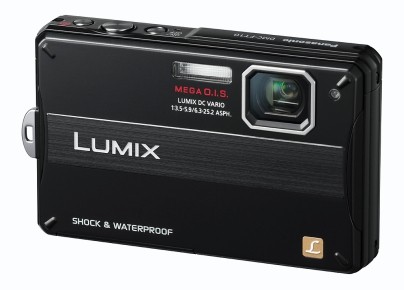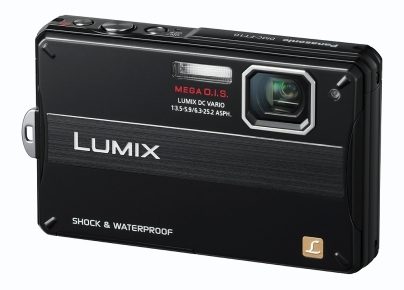The Panasonic Lumix DMC-FT10 is the second waterproof camera I have owned. The first one was the first of this kind (as far as I know) – the Olympus Tough, can’t really remember the model. The Olympus died on me two times. First it was still under warranty so I got it fixed and the second time just when the warranty was over it got flooded big time. I’m no sure if it was my fault, maybe I didn’t clean the seals or something… but it was completely wet inside and it died. I also noticed that the photo quality deteriorated over time… anyway – I was waterfroofcameraless for a while, but then before my Bali trip, I was again in a market for a new waterproof digital camera.
As I sipped through the various reviews and forums it crystallized that Panasonic is the best bet at the moment. I already had my eyes set on Panasonic Lumix DMC-FT3 which is the top end model from the Panasonic waterproof camera range but guess what – it is (was?) made in a factory near Fukushima and my shopping time was right after the tsunami and power plant accident and they were nowhere to be found.
So I went for the cheapest one instead – the Panasonic Lumix DMC-FT10 which set me back about 180€. The biggest difference as far as a surfer can be concerned between the two is the depth of water that it survives. The DMC-FT3 can stand 12m (39ft) of water pressure and DMC-FT10 only 3m (10ft). No duck diving under waves over 10ft :)? So far the camera has survived all the duckdives and wipeouts and washing machine cycles. So I think it can survive everything that an average surfer throws it’s way. OK, first some technical details and then my thoughts on the camera.
Panasonic Lumix DMC-FT10 Technical Info
| Sensor | • 1/2.33″ Type CCD • 14.5 million pixels total • 14.1 million effective pixels |
|---|---|
| Image sizes | 4:3 • 4320×3240(14M) • 3648×2736(10M EZ) • 2560×1920(5M EZ) • 2048X1536(3M EZ) • 640X480(0.3M EZ) 3:2 • 4320 x 2880 (12.5M) 16:9 • 4320 x 2432 (10.5M) |
| Movie clips | • Motion JPEG: 1280 x 720 pixels @ 30fps • 4:3: 640 x 480 pixels, 320 x 240 pixels @ 30 fps • 16:9: 848 x 480 pixels @ 30 fps |
| File formats | • Still Image: JPEG(DCF/Exif2.21) • Motion picture: QuickTime Motion JPEG |
| Lens | • 4x optical zoom • 35 – 140mm (35mm equiv.) • f=6.3-25.2mm • F3.5 – 5.6 • LUMIX DC VARIO • 11 elements in 10 groups |
| Image stabilization | Mega O.I.S lens-shift stabilization |
| Digital zoom | Yes, up to 4x |
| Focus | • Normal • Macro • Zoom Macro • Quick AF (Always on) |
| AF area modes | • Face • 9-point • 1-point |
| AF assist lamp | Yes |
| Focus distance | • Normal: Wide 50cm – infinity, Tele 50 cm – infinity • Macro / Intelligent AUTO/ Clipboard: Wide 10 cm / Tele 50cm – infinity |
| Metering | • Intelligent Multiple |
| ISO sensitivity | • Auto • 80 • 100 • 200 • 400 • 800 • 1600 • High Sensitivity Mode : Auto (1600 – 6400) |
| Exposure compensation | ± 2 EV, 1/3EV steps |
| Exposure bracketing | ± 1/3 EV ~ 1EV step, 3 frames |
| Shutter speed | • 8-1/1600 sec • Starry Sky Mode : 15, 30, 60sec |
| Aperture | • F3.5 – 5.9 (F3.5 – 5.6 (W) / F5.9 – 7.1 (T)) |
| Modes | • Intelligent AUTO • Normal Picture • SCN • My SCN • Motion Picture |
| Scene modes | • Portrait • Soft Skin • Transform • Self-Portrait • Scenery • Sports • Night Portrait • Night Scenery • Food • Party • Candle Light • Baby1 • Baby2 • Pet • Sunset • High sensitivity • Hi-Speed Burst • Flash Burst • Starry Sky • Fireworks • Beach & Surf • Snow • Aerial photo • Photo Frame • Film Grain |
| White balance | • Auto • Daylight • Cloudy • Shade • Halogen • White Set |
| Self timer | 2, 10 sec |
| Continuous shooting | • 1.5 frames/sec • 4.6 frames/sec High Speed Burst mode |
| Image parameters | Standard, Vivid, Natural, Black & White, Sepia, Cool, Warm |
| Flash | • Auto, Auto/Red-eye Reduction, Forced On, Slow Sync./Red-eye Reduction, Forced Off • 0.3 – 4.9m (Wide/ISO Auto), 0.5 – 2.9m (Tele/ISO Auto) |
| Viewfinder | No |
| LCD monitor | • 2.7″ TFT LCD Display • 230K dots • Field of View : approx. 100% • AUTO Power LCD mode, Power LCD mode |
| Connectivity | • USB2.0 High speed • AV Output (NTSC/PAL) • DC Input |
| Storage | • SD/SDHC/SDXC Memory Card • 40MB internal memory |
| Power | • Li-ion battery • Charger included • AC adaptor (optional) |
| Weight (no batt) | 152 g |
| Weight (with batt) | 172 g |
| Dimensions | 100 x 64 x 22 mm (3.95 x 2.5 x 0.85 in) |
Now that’s a lot of info :). Now some comments:
14MP
is almost too much, this is the specification where companies can most easily wow the buyers but 4-5Mb photos are a pain in the ass to handle. But on the other hand – I prefer this kind of camera over the GoPro Hero because it can be used in and out of the water for everyday shooting. Houses, animals, plants, friends… and of course shooting surfing from the beach. When shooting from the beach you need zoom. All the waterproof cameras only have 3-5x optical zoom since all the lenses are packed into the housing and are not extended from it to keep the camera waterproof. So here high pixel count comes in handy. You can crop and enlarge the surfer later on your computer. Still – the quality of this kind of crop is much worse than a photo made originally with more optical zoom – longer lens. So don’t get your hopes too high.
Photo quality
It’s good! I had quite a few remarks that people like my photos and a friend of mine even bought the same camera because he liked my photos. I will show you some photos later but I must warn you that they are manipulated in Photoshop. Camera itself makes very decent photos but to get that extra something out of them you need to do some image manipulation. In this case it is important that camera catches enough info, enough pixel information for your photos. This way the end result will be much better and for an under 200€ camera I can say that I am satisfied.
Here is a link to my surfing in Peniche Portugal report that has a gallery of photos made with Panasonic Lumix DMC-FT10.
Waterproof
So far so good. I have been using this camera for a good 6 months. In this time I took it into the water like 20-30 times for 2-4hour surf sessions. After the last surf I did noticed some water behind the battery cover, I hope it’s just a matter of getting all the sand out of the rubber seals. How does this waterproof thing work? Basically you have two covers that have a rubber seal on them. One is for the battery and SD card and the other is for the connection cables. When you close the covers this rubber is pushed into the housing and it seals the insides. If there is some dirt on the rubber water can get in so be careful. No rocket science here I guess :) I also wonder what is the difference between 3m and 12m versions when it comes to this.
LCD screen
It is bright enough most of the time. Which means you can even see something when you are siting on your surfboard in a lineup under tropical sun at noon.
HD Clips
Camera can make 720p HD clips which are OK, but nothing to be really excited about. Don’t buy this camera for making movies. Then again don’t buy any waterproof camera of this kind for making movies. Just get the GoPro Hero instead.
Scene Modes
This camera has loads of scene modes which in most cases do make a difference when making photos. I mostly use: sunset for cool evening shots, film grain for artsy B&W look, night portrait to get the flash and that long exposure time, sports mode for shooting surfing and normal picture that opens all the available picture settings.
Then there is also the intelligent auto that sets everything for you but also closes most of the manual settings. It even has it’s own button on the top of the camera so it’s always ready and at the reach of your finger. This is great stuff and really useful so when you have to be quick your camera is ready right away and you don’t have to crawl over countless menus to get out of the scene mode you are currently in!

Surfing With Panasonic Lumix DMC-FT10
At 172 grams it is light enough that you can surf with it stuck in your boardshorts pocket. You will feel a little pull on your boardshorts (of course) but not so much that you couldn’t keep your mind of while surfing.
If you are wearing a wetsuit it’s more of a problem. The only way I take this kind of camera with me is if I have a zipperless wetsuit. The zipperless system creates some kind of pocket in most of the wetsuits and you can stuff the camera in there and connect the camera leash to the elastic band used to tighten the wetsuit. This way even if it falls out which for me never happened it is connected to you. DMC-FT10 doesn’t float and nor does any other camera of this kind.
Conclusion?
I like it :)! If you have any questions ask in the comments.


Hello K
Have just read your great review, thanks.
I am looking at buying my first water proof compact camera – a second hand FT 10 of course.
I notice that your review was written a couple of years ago now, what happened to yours?
Any further tips or comments?
Thanks
Ashley
Hi Ashley,
I still have it and use it, no problems so far, it’s still dry inside:) – I just took some photos with it 2 weeks ago… four water shots here were made with FT10. If you are going to use it in the water a lot, buy it!